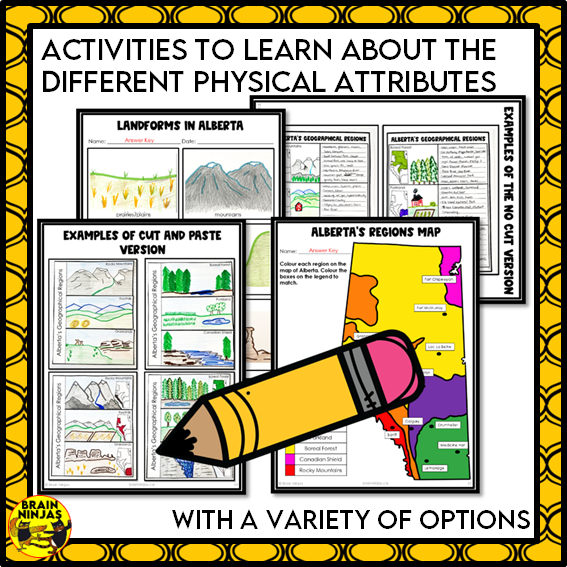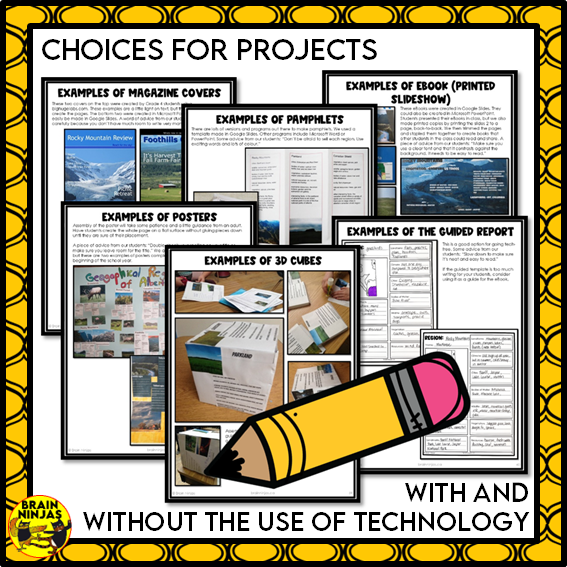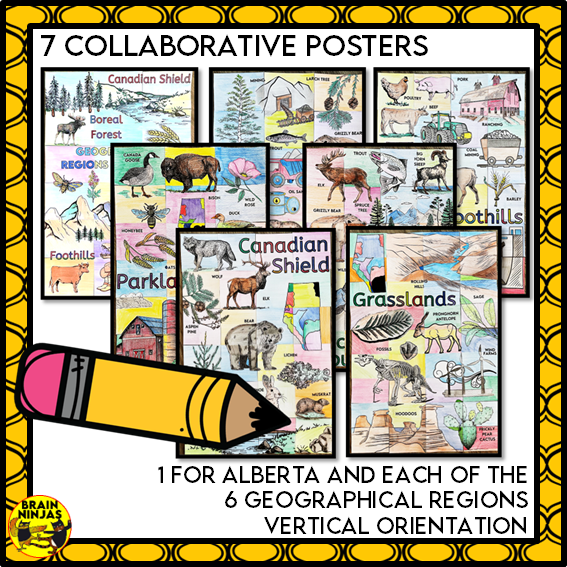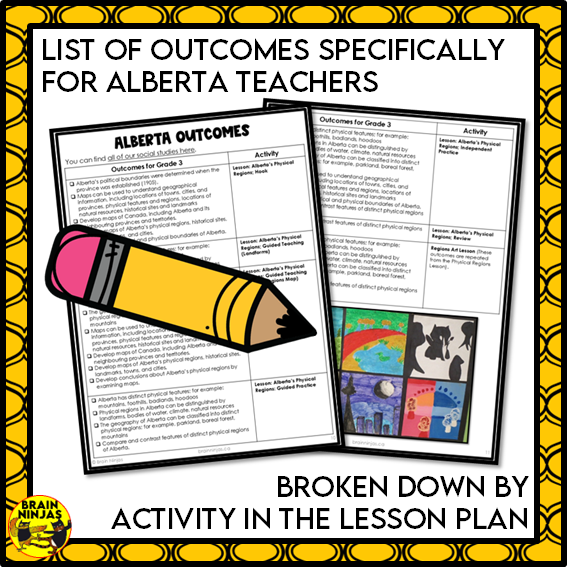Alberta Regions Project Bundle | Paper and Digital
Alberta Regions Project Bundle | Paper and Digital
Couldn't load pickup availability
These project-based learning activities guide students through the geographical regions of Alberta. These activities require only moments to prep. Students are challenged to research the different Alberta regions, but everything teachers need is included such as background knowledge for teachers and a student reading passage for each region.
Get Grade 3 Alberta Social Studies for a full year and save money at the same time.
The Alberta Regions Project includes:
- Boreal Forest, Parkland, Rocky Mountains, Grasslands, Foothills, and the Canadian Shield. This is based on the resources we have available in our school. Most of the activities can still work if you use different regions (except the map and the cube activity).
- information about natural resources, physical features, towns/cities, vegetation, animals, climate and landmarks for each region.
- a map lesson to learn the different regions of Alberta.
- a lesson about landforms.
- instructions for how to use our activities with and without technology so you can be flexible for your students and classroom environment.
- instructions for printing student workbooks while still offering differentiated options.
- detailed outlines of each activity with a list of materials along with a centralized list and reminders in each section of the lesson plan.
- optional Teacher Slides to support instruction and content delivery. You can choose to teach with or without them.
- vocabulary list with phonetic pronunciations and definitions to help support your students.
- “I can” statements written in student-friendly language so students can self-assess their learning.
- an interactive notebook template lesson to learn the different landforms for each region. This gives students the chance to learn some of the basic similarities and differences of the regions before starting on their projects.
- six different project-based learning activities for students to choose from. These projects further deepen the understanding of the regions. Students create a project and present it. Some of the projects can be done digitally.
- suggestions for how to do project-based learning in your classroom.
- background information about each region for the teacher.
- assessment rubrics for the projects.
- simple quizzes and assessment activities to see what students know about the different geographical regions.
- self-assessment opportunities for students so they can review their work.
- an art project that wraps up the lessons so students can show off what they have learned.
- modifications to help you differentiate without spending more of your time.
- photographs of student examples.
- checklists for each project.
- advice from our students.
- the ability to pick and choose so it can work in your classroom.
- digital versions of most of the pages to help support your students or reduce printing. To access the digital version, download the PDF and use the link inside that file.
- a list of Alberta outcomes to help with planning.
The Alberta Regions Reading Passages include:
- six reading passages designed to support learning about Alberta's six geographical regions. These passages may need to be read with teacher support, particularly at the beginning of the Grade 3 school year. The digital version has loose text that can be read by your assistive software.
- information about natural resources, physical features, towns/cities, vegetation, animals, climate and landmarks for each region.
- text features: bolded words, text boxes, maps, captions, photographs, tables, charts
- instructions on ways to use the read materials to support your social studies program
- a set of cover pages for each region for the paper version if you wish to make printed versions.
- instructions on ways to use the reading passages as paper pages or digitally. To use the digital version, you will need to download the PDF and click on the link in the resource.
- since these are reading passages designed to be used in place of a textbook, there are no comprehension questions, lessons or assignments included in this resource.
- list of Alberta outcomes to help with planning.
The Alberta Regions Collaborative Posters Activity includes:
- 7 collaborative posters you can use any time of year.
- directions to run the activity with your students, starting with an overview of the six regions in Alberta and following up with each of the six individual regions in more detail.
- examples of some of the natural resources, vegetation, landmarks and animals found in each region.
- sets in 18, 24 or 36 pieces, so you can use them with any size class.
- simple instructions for your students.
- overview image to show where each piece fits into the final poster.
- pieces with different levels of detail so you can differentiate slightly.
- assembly instructions with tips for making the process as easy as possible.
- follow-up activities to extend learning about each of the regions.
- a vertically oriented poster. Final poster sizes depend on your printer settings, but the approximate sizes are 18 pieces 60 by 90 cm, 24 pieces 72 by 108 cm and 36 pieces 80 by 135 cm.
- individual piece sizes 18 pieces 20 by 15 cm, 24 pieces 18 by 18 cm, 36 pieces 20 by 15 cm.
- list of Alberta outcomes to help with planning.
Ninja Note: If you teach in Alberta, this resource has been updated for the new social studies curriculum. Learn more about how we're writing and adjusting resources for the new curriculum. https://brainninjas.ca/social-studies-in-alberta/
These activities align with:
- the Alberta Social Studies Curriculum Grade 3 ©2025
- the Alberta Program of Studies Grade 4 Social Studies (old outcomes)
Looking for more social studies for Alberta teachers?
- Time and Place Unit for Alberta Social Studies Grade 3
- Systems Unit for Alberta Social Studies Grade 3
-
Citizenship Unit for Alberta Social Studies Grade 3
Our Grade 3 Social Studies Full Year is here.
Ninja Note: This file is a ZIP file. It contains all the PDF files that contain each unit. Buyers need to download the ZIP and extract the PDF files to a computer. To access the digital version, download the PDF and use the link in that file.
Have a question? Before contacting us, check our Frequently Asked Questions page.


































